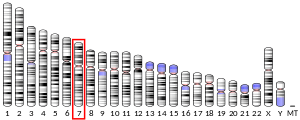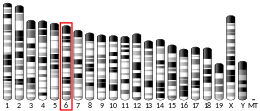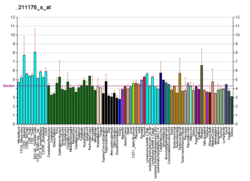PAX4
Paired box gene 4, also known as PAX4, is a protein which in humans is encoded by the PAX4 gene.[5][6][7]
Function
This gene is a member of the paired box (PAX) family of transcription factors. Members of this gene family typically contain a paired box domain, an octapeptide, and a paired-type homeodomain. These genes play critical roles during fetal development and cancer growth. The paired box gene 4 is involved in pancreatic islet development and mouse studies have demonstrated a role for this gene in differentiation of insulin-producing beta cells.[5]
gollark: No, I prefer yellow heptagons.
gollark: Not particularly.
gollark: You attain XP and put that into skills, I think?
gollark: Why not just sample from arbitrary binomial distributions?
gollark: The GRules™ are better.
See also
References
- GRCh38: Ensembl release 89: ENSG00000106331 - Ensembl, May 2017
- GRCm38: Ensembl release 89: ENSMUSG00000029706 - Ensembl, May 2017
- "Human PubMed Reference:". National Center for Biotechnology Information, U.S. National Library of Medicine.
- "Mouse PubMed Reference:". National Center for Biotechnology Information, U.S. National Library of Medicine.
- "Entrez Gene: PAX4 paired box gene 4".
- Matsushita T, Yamaoka T, Otsuka S, Moritani M, Matsumoto T, Itakura M (Jan 1998). "Molecular cloning of mouse paired-box-containing gene (Pax)-4 from an islet beta cell line and deduced sequence of human Pax-4". Biochemical and Biophysical Research Communications. 242 (1): 176–80. doi:10.1006/bbrc.1997.7935. PMID 9439631.
- Inoue H, Nomiyama J, Nakai K, Matsutani A, Tanizawa Y, Oka Y (Feb 1998). "Isolation of full-length cDNA of mouse PAX4 gene and identification of its human homologue". Biochemical and Biophysical Research Communications. 243 (2): 628–33. doi:10.1006/bbrc.1998.8144. PMID 9480859.
Further reading
- Al-Hasani K, Pfeifer A, Courtney M, Ben-Othman N, Gjernes E, Vieira A, Druelle N, Avolio F, Ravassard P, Leuckx G, Lacas-Gervais S, Ambrosetti D, Benizri E, Hecksher-Sorensen J, Gounon P, Ferrer J, Gradwohl G, Heimberg H, Mansouri A, Collombat P (Jul 2013). "Adult duct-lining cells can reprogram into β-like cells able to counter repeated cycles of toxin-induced diabetes". Developmental Cell. 26 (1): 86–100. doi:10.1016/j.devcel.2013.05.018. PMID 23810513.
- Collombat P, Xu X, Ravassard P, Sosa-Pineda B, Dussaud S, Billestrup N, Madsen OD, Serup P, Heimberg H, Mansouri A (Aug 2009). "The ectopic expression of Pax4 in the mouse pancreas converts progenitor cells into alpha and subsequently beta cells". Cell. 138 (3): 449–62. doi:10.1016/j.cell.2009.05.035. PMC 2792203. PMID 19665969.
- Sosa-Pineda B (Dec 2004). "The gene Pax4 is an essential regulator of pancreatic beta-cell development". Molecules and Cells. 18 (3): 289–94. PMID 15650323.
- Stapleton P, Weith A, Urbánek P, Kozmik Z, Busslinger M (Apr 1993). "Chromosomal localization of seven PAX genes and cloning of a novel family member, PAX-9". Nature Genetics. 3 (4): 292–8. doi:10.1038/ng0493-292. PMID 7981748.
- Tamura T, Izumikawa Y, Kishino T, Soejima H, Jinno Y, Niikawa N (1994). "Assignment of the human PAX4 gene to chromosome band 7q32 by fluorescence in situ hybridization". Cytogenetics and Cell Genetics. 66 (2): 132–4. doi:10.1159/000133684. PMID 8287686.
- Pilz AJ, Povey S, Gruss P, Abbott CM (1993). "Mapping of the human homologs of the murine paired-box-containing genes". Mammalian Genome. 4 (2): 78–82. doi:10.1007/BF00290430. PMID 8431641.
- Matsushita T, Yamaoka T, Otsuka S, Moritani M, Matsumoto T, Itakura M (Jan 1998). "Molecular cloning of mouse paired-box-containing gene (Pax)-4 from an islet beta cell line and deduced sequence of human Pax-4". Biochemical and Biophysical Research Communications. 242 (1): 176–80. doi:10.1006/bbrc.1997.7935. PMID 9439631.
- Inoue H, Nomiyama J, Nakai K, Matsutani A, Tanizawa Y, Oka Y (Feb 1998). "Isolation of full-length cDNA of mouse PAX4 gene and identification of its human homologue". Biochemical and Biophysical Research Communications. 243 (2): 628–33. doi:10.1006/bbrc.1998.8144. PMID 9480859.
- Bonthron DT, Dunlop N, Barr DG, El Sanousi AA, Al-Gazali LI (Apr 1998). "Organisation of the human PAX4 gene and its exclusion as a candidate for the Wolcott-Rallison syndrome". Journal of Medical Genetics. 35 (4): 288–92. doi:10.1136/jmg.35.4.288. PMC 1051275. PMID 9598721.
- Tao T, Wasson J, Bernal-Mizrachi E, Behn PS, Chayen S, Duprat L, Meyer J, Glaser B, Permutt MA (Oct 1998). "Isolation and characterization of the human PAX4 gene". Diabetes. 47 (10): 1650–3. doi:10.2337/diabetes.47.10.1650. PMID 9753306.
- Smith SB, Watada H, Scheel DW, Mrejen C, German MS (Nov 2000). "Autoregulation and maturity onset diabetes of the young transcription factors control the human PAX4 promoter". The Journal of Biological Chemistry. 275 (47): 36910–9. doi:10.1074/jbc.M005202200. PMID 10967107.
- Miyamoto T, Kakizawa T, Ichikawa K, Nishio S, Kajikawa S, Hashizume K (Mar 2001). "Expression of dominant negative form of PAX4 in human insulinoma". Biochemical and Biophysical Research Communications. 282 (1): 34–40. doi:10.1006/bbrc.2001.4552. PMID 11263967.
- Shimajiri Y, Sanke T, Furuta H, Hanabusa T, Nakagawa T, Fujitani Y, Kajimoto Y, Takasu N, Nanjo K (Dec 2001). "A missense mutation of Pax4 gene (R121W) is associated with type 2 diabetes in Japanese". Diabetes. 50 (12): 2864–9. doi:10.2337/diabetes.50.12.2864. PMID 11723072.
- Kanatsuka A, Tokuyama Y, Nozaki O, Matsui K, Egashira T (Sep 2002). "Beta-cell dysfunction in late-onset diabetic subjects carrying homozygous mutation in transcription factors NeuroD1 and Pax4". Metabolism. 51 (9): 1161–5. doi:10.1053/meta.2002.34707. PMID 12200761.
- Shimajiri Y, Shimabukuro M, Tomoyose T, Yogi H, Komiya I, Takasu N (Mar 2003). "PAX4 mutation (R121W) as a prodiabetic variant in Okinawans". Biochemical and Biophysical Research Communications. 302 (2): 342–4. doi:10.1016/S0006-291X(03)00176-1. PMID 12604352.
- Kemp DM, Lin JC, Habener JF (Sep 2003). "Regulation of Pax4 paired homeodomain gene by neuron-restrictive silencer factor". The Journal of Biological Chemistry. 278 (37): 35057–62. doi:10.1074/jbc.M305891200. PMID 12829700.
- Holm P, Rydlander B, Luthman H, Kockum I (Jun 2004). "Interaction and association analysis of a type 1 diabetes susceptibility locus on chromosome 5q11-q13 and the 7q32 chromosomal region in Scandinavian families". Diabetes. 53 (6): 1584–91. doi:10.2337/diabetes.53.6.1584. PMID 15161765.
- Brun T, Franklin I, St-Onge L, Biason-Lauber A, Schoenle EJ, Wollheim CB, Gauthier BR (Dec 2004). "The diabetes-linked transcription factor PAX4 promotes {beta}-cell proliferation and survival in rat and human islets". The Journal of Cell Biology. 167 (6): 1123–35. doi:10.1083/jcb.200405148. PMC 2172618. PMID 15596543.
External links
- PAX4+protein,+human at the US National Library of Medicine Medical Subject Headings (MeSH)
This article incorporates text from the United States National Library of Medicine, which is in the public domain.
This article is issued from Wikipedia. The text is licensed under Creative Commons - Attribution - Sharealike. Additional terms may apply for the media files.





